|
Mar
31
2025
|
|
Posted 259 days ago ago by Admin
|
|
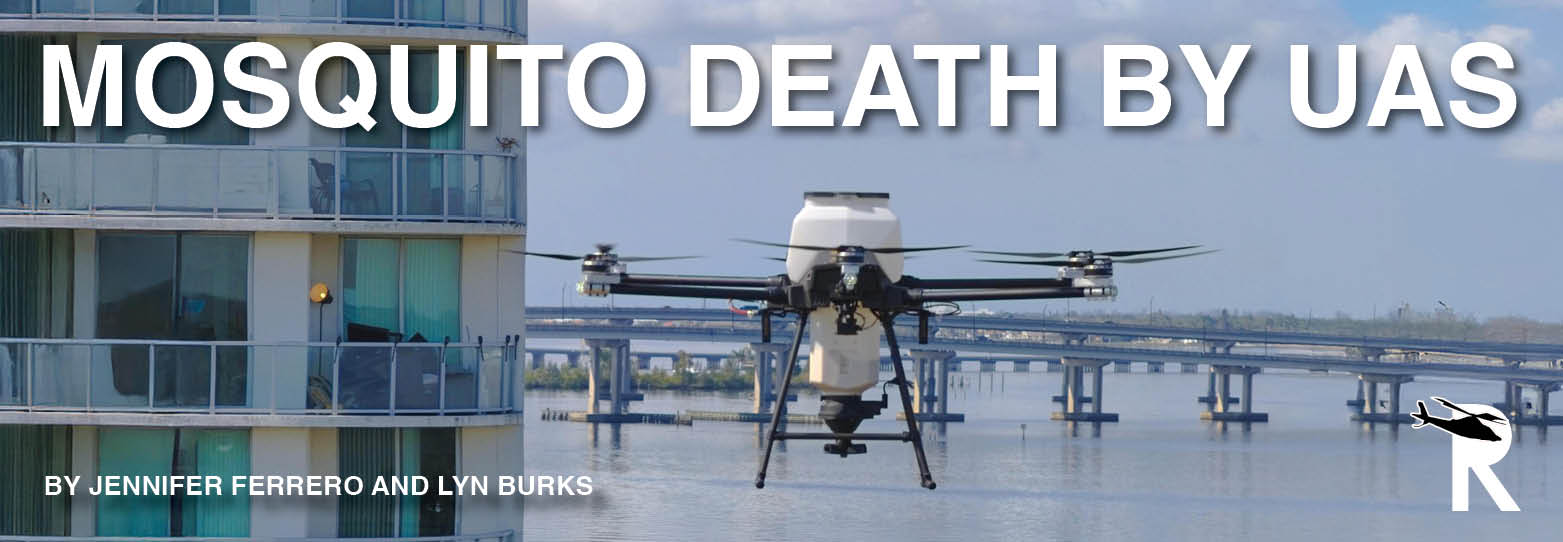
Ironically, flying unmanned aerial systems (UAS) can often sound like buzzing mosquitoes. You can hear them buzzing in on approach, and eventually, when close enough, you can see them peering down at you from above. Yet, UAS is a new solution to controlling mosquito populations in Lee County, Florida. Mosquitoes serve many purposes in a healthy balanced ecosystem. In fact, mosquitoes are considered pollinators, as much as any bee or butterfly. Having said that, the average citizen likely believes that they have no useful purpose, because their proliferation of peskiness knows no end. They irritate us on beaches, hiking, and working with animals. They can cause serious disease and eventually death for mammals, reptiles and birds, and they are incessantly difficult to kill. Mosquito diseases can affect humans, horses, birds, dogs, cats, and more.
Lee County Mosquito Control District (LCMCD) aims to rectify this problem. It currently has multiple methods of mosquito abatement. Its mosquito aircraft arsenal includes fixed-wing aircraft, helicopters, and UAS, and its human arsenal includes personnel like biologists, pilots, public information officers, and accountants. They also include facilities and ground maintenance, plus mechanics for aircraft maintenance. They are tasked with ensuring public health through their efforts, which is quite an operation. LCMCD partners with government agencies, academia, private sector enterprises, and community partners.
Traditional methods of killing mosquito populations to deter risk for humans and animals include spraying insecticides via helicopter and fixed-wing aircraft to control mosquito populations in all stages of their life cycle. These aircraft are great for covering large territories and bear unique operational limitations such as increased financial cost, environmental impact, and safety risks.
Mosquito Control Districts exist throughout Florida and the US, often operating on a County level within each State. Ranging from small single-County Departments to multi-County Special Taxing Districts, the scale of mosquito control operations varies upon the needs and demands of the citizens.
Many are starting to use Unmanned Systems and Lee County strives to be a leader in this field.
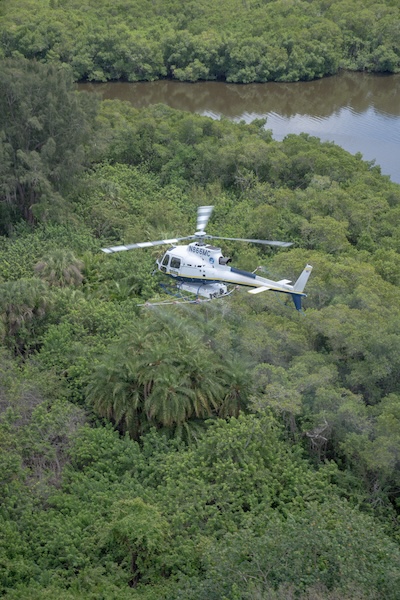
Prior to adopting UAS into their fleet, they purchased both helicopters and fixed-wing aircraft, which are still utilized. They have two turbo-prop DC-3s, four turbo-prop King Air fixed wings, and six H125 helicopters. These aircraft cover large areas where they can apply targeted mosquito control treatments.
UAS now allows them to target very small areas where mosquitoes are breeding. LCMCD said, “The first niche identified for UAS Operations was in aerial larvicide applications. Sites deemed too large or inaccessible for treatment via standard ground resources (sprayers, backpack blowers, etc.) and too small, obscure, unsafe or obtrusive for our standard manned aircraft approach were ideal for UAS treatments.”
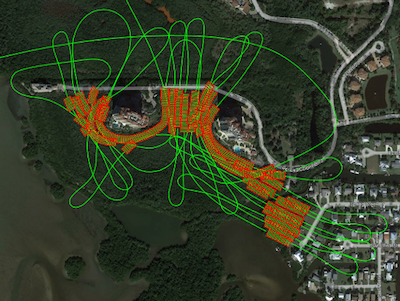
It lets them methodically get down into smaller areas, followed by residential or commercial buildings near standing water. "We do this (with UAS) with the same application rate, at a fraction of the speed, and a fraction of the cost," said ...said Nicholas Lefkow, Lead GIS Imagery Analyst and UAS Pilot, Lee County Mosquito Control District.
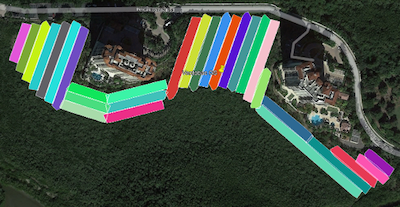
If an area is too dense for aircraft, including helicopters, they can now use the UAS to deeply navigate into the more "targeted polygons." Variables such as the manned aircraft’s ground speed, the size or shape of a target, proximity to sensitive infrastructure, or even the comfort of new “Floridians” experiencing our operations for the first time can make helicopters less than ideal compared to their Unmanned counterparts. They say there is an art and science to killing mosquito populations. They respond to residents who call in to complain about infestations and send personnel to investigate. Sometimes, it is mosquitoes, and sometimes, it is another annoying bug.
Field inspectors go on-site to research "retention areas" or stagnant water, and they consult with the aerial inspector on the site. They will then "draw up" a treatment plan using mapping technology and determine if a site is best suited for ground treatment, UAS treatment, or helicopter treatment. They also select the chemical required to target the species of mosquito observed in the field.
Lefkow said everything they do is quantifiable. They confirm and classify larvae in the water and adults flying in the air to determine the best approach, enabling more targeted, precision applications. He added, “LiDAR and field validation techniques improve the science of mosquito control quantifying metrics that were previously unmeasurable.”
The UAS program for LCMCD has evolved since 2017, first with the purchase of (1) DJI Phantom 4 Pro sUAS and (1) SwellPro Splash Drone sUAS, which they said were provided for limited aerial inspections when helicopters were not available for every aerial inspector. Then, in 2017, the FAA selected them to participate in an Integration Pilot Program (IPP).
They said, "By 2018, original proposals to deploy a 1,500-lb, fixed-wing Teros UAS were deemed unfeasible for one of the smallest agencies in the IPP. Alternatives were investigated, and the decision was made to step away from the IPP in pursuit of a more modest pace into unmanned aviation."
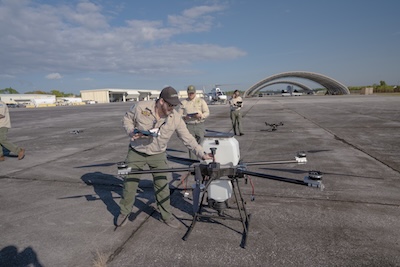
By 2018, they trained remote pilots to conduct aerial larvicide applications. By 2021, they created a team for Unmanned Aerial Systems (UAS) operations by hiring a UAS Pilot and a GIS Imagery Analyst. The team's focus was on "larvicide applications, simultaneously supplementing the range of a Field Inspectors treatment by hand and the precision of our aerial helicopter applications. Our second objective was in-house LiDAR acquisition and analytics from both manned and unmanned aircraft," said Lefkow.
From a practical perspective, field validation biologists contact the UAS Pilots to observe and report on meteorological conditions during their field trials. These metrics bring new levels of awareness and control into their scientific method, refining our approach to mosquito control.
LCMCD Drone Fleet, equipment, functions, and benefits:
• Aerial Larvicide Applications (Unmanned Aerial Spray System): (1) PrecisionVision 40X UASS
• Unmanned LiDAR Acquisition: (1) Freefly Alta X UAS
• Aerial & Geometric Mapping (Orthomosaic): (1) Freefly Astro sUAS
• Inspections: (1) Skydio X10 sUAS
Lefkow said that what UAS is doing for the industry is refining the verification of metrics, the application rate per acre, and what used to be anecdotal evidence from a field biologist and quantifying it across the board with more precision. "So, we're finding opportunities like we were seeing today where we can apply far more targeted and precise applications." He added that this solves a problem for more densely populated areas near residential homes with periodic stagnant water.
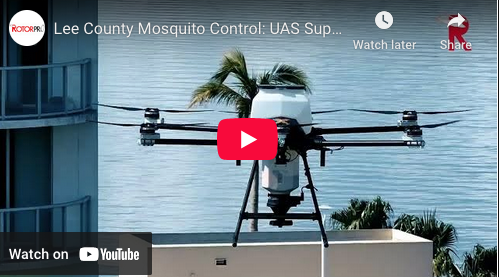
Considering technological advancement, Lefkow said, "the evolutionary pace of UAS technology certainly exceeds our current demands. Before one aircraft model meets its operational or airworthiness limits, new ones enter the market that raise the standard."
Once a site is deemed unfit for Ground Larvicide treatment, it is a team effort to determine whether it is a manned or unmanned aerial application. Lefkow said they provide fact sheets to the field inspectors that define flight distance, battery life, and application information to determine what to use. Lefkow said it is a "decision tree" they will first go to the aerial field inspector, "who does the inspections along the coastline and into mangroves."
For example, the field and aerial inspectors work together to find locations where mosquitoes are laying eggs and may hatch. Once they identify mosquito larval habitat, they work with a biologist and chief pilot to develop a plan to determine which aircraft will best fit. Lefkow said, "Everything is based upon time and weather and includes tides. It is all based upon the water and when they are hatching as adults." He said if they wait too long or use the wrong application method, they could miss killing the larvae before they hatch, and the problem could worsen.
The organization uses different techniques to control mosquito populations. They said it takes a variety of methods to reach mosquitoes. Adulticides are insecticides used to kill adult mosquitoes. Larvicides are insecticides used to kill immature mosquitoes, specifically the larvae and pupae..
They use helicopters to spread larvicide applications with a spray tank using either liquid or granular larvicide formulations. With UAS, they use larvicide only in a granular form. Recently, they spread 40 acres of larvicide using a drone. They didn't use a helicopter for that application because powerlines crisscrossed the area. The limitation of using UAS in a larger area is battery power, so they carry extra batteries to disseminate the larvicide.
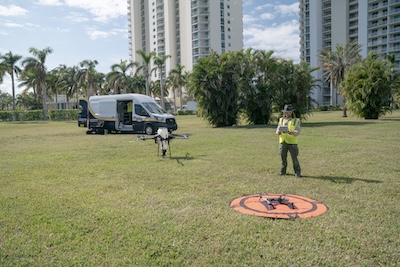
Piloting UAS requires training and Part 107 Remote Pilot Certification. Pilots can earn degrees from community colleges and universities or obtain in-house training. When they deploy new systems, pilots receive training from the drone manufacturer.
The industry is rapidly developing, and so is technology, so their pilots must continually re-train. There are webinars, seminars, and community engagement opportunities for their pilots to evolve.
Looking forward, LCMCD plans to establish protocols for the unmanned aerial release of sterile male mosquitoes produced by their in-house Sterile Insect Technique (SIT) Department. This means producing and sterilizing male mosquitoes in a lab and then overwhelming a wild population of healthy females with sterile suitors. The males act as tiny homing missiles programmed to seek out female mosquitoes wherever they may hide, and perhaps pollinate a few flowers along the way. The females are unaffected by the sterile males except that the eggs they produce from this exchange will not be viable. This biological pest control technique significantly reduces new hatches of mosquito species commonly found around human habitation, without the use of chemical control.
Unmanned aerial release of these sterile males will provide them with better distribution throughout an area and an increased opportunity to “successfully” mate with a wild female.
As an add-on to the program, they also mitigate water hyacinths, which are also invasive and grow in standing water. The hyacinths will block light and oxygen in the rivers and streams. Through the combined efforts in Lee County, they use airboats, trucks, aquatic harvesters, and UAS. They use UAS to spray the plants to kill them. However, they try to use airboats unless there is no access.
For both organizations, killing invasive insects and plants can be done in conjunction, and using UAS, along with other methods, is a key method of attack.
VIEW FEATURE VIDEO
READ MORE ROTOR PRO: https://justhelicopters.com/Magazine
WATCH ROTOR PRO YOUTUBE CHANNEL: https://buff.ly/3Md0T3y
You can also find us on
Instagram - https://www.instagram.com/rotorpro1
Facebook - https://www.facebook.com/rotorpro1
Twitter - https://twitter.com/justhelicopters
LinkedIn - https://www.linkedin.com/company/rotorpro1